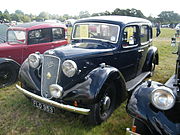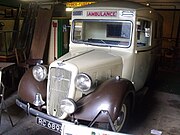
The Austin Sixteen Light Six is a British car that was made by Austin from 1927. Announced in October 1927, the first deliveries were planned for March 1928.

The Austin Ten is a small car that was produced by Austin. It was launched on 19 April 1932 and was Austin's best-selling car in the 1930s and continued in production, with upgrades, until 1947. It fitted in between their "baby" Austin Seven which had been introduced in 1922 and their various Austin Twelves which had been updated in January 1931.
The Rover 8 was a small single-cylinder 8 hp 1327 cc car made by the British Rover car company. It was Rover's first production car. It was remarkable for being supported by a backbone chassis rather than a conventional ladder frame. The first model was manufactured from 1904 to 1912. A Daimler-Knight sleeve valve engine option was available on the original model in 1911 and 1912.

The Austin 10 hp is a high-quality small car produced between 1910 and 1915 by the British car manufacturer Austin Motor Company Limited at their Longbridge, Worcestershire plant near Birmingham. 1,336 cars were made, 213 with the 1125 cc engine and 1,123 with the 1615 cc engine. Like the 1087 cc Austin 7 hp produced by both Austin and Du Cros's Swift Motor Company it was not very successful when sold with the small engine.

The Austin Light Twelve-Six is a 14 tax horsepower car with a 1496 cc engine that was introduced by Austin in January 1931. It was named by Austin Light Twelve to separate it from the well-established Austin Twelve. The general public then dubbed the original Twelve Heavy Twelve but Austin never used that name. The Light Twelve-Six remained in production until 1936.

The Austin Light Twelve-Four is a car that was produced by Austin from 1933 until 1939. It was replaced in 1939 by a completely new car also called the Austin 12 which kept the same engine. The "12" in the name referred to the taxation horsepower, a British rating which controlled the annual taxation payable to use the car on the road.

The Hillman Fourteen is a medium-sized 4-cylinder car announced by Hillman's managing director Spencer Wilks, a son-in-law of William Hillman, at the end of September 1925. This new Fourteen substantially increased Hillman's market share and remained on sale into 1931. During this time it was the main product of the company.

The Rover 12 was a name given to several medium-sized family cars from the British Rover car company between 1905 and 1948.

The Standard Flying Fourteen is an automobile produced by the British Standard Motor Company from 1936 to 1940 and announced in October 1936. The other Flying Standard models had been announced twelve months earlier. A standard is a flag and the reference to flying standards is to flying flags as well as to the advertised abilities of the cars.
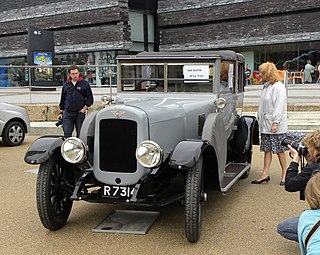
Austin Twenty is a large car introduced by Austin after the end of the First World War, in April 1919 and continued in production until 1930. After the Austin 20/6 model was introduced in 1927, the first model was referred to as the Austin 20/4.

The Lanchester Eighteen at first known as the 15/18 was announced at the beginning of October 1931. Quite unlike any previous Lanchester it was their first new car following BSA's takeover of The Lanchester Motor Company Limited in January 1931. A medium sized car was a new departure for Lanchester.
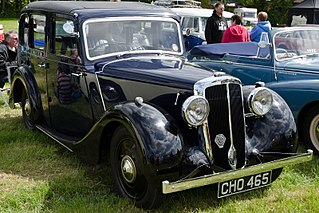
The Lanchester Fourteen Roadrider is a six-cylinder automobile introduced by the Lanchester Motor Company in the beginning of September 1936. It was named "Roadrider" for its special suspension features, and billed as the lowest-priced six-cylinder Lanchester ever offered. This car replaced the previous 12 hp Light Six model with a larger six-cylinder engine again in the Lanchester Eleven chassis and body.

The Austin 15 hp is a 2.8-litre motor car manufactured by the British manufacturer Austin and first displayed at the seventh exhibition of motor vehicles which opened at London's Olympia in November 1908. Its tax rating was 20 horsepower. It was sold between 1908 and 1915.
The Rover Fourteen was a medium-sized family car and variants produced by the British Rover car company between 1924 and 1948. Civilian automobile production was interrupted in 1940 because of the war, but when the war ended in 1945, the Rover 14 returned to the market and remained available until replaced by the Rover 75 at the beginning of 1948.
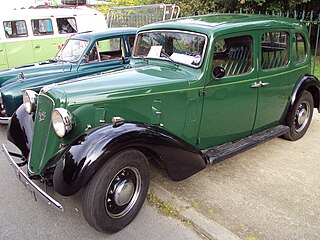
The Austin Fourteen is a 1.7-litre saloon that was introduced by Austin in August 1936 and available as a Goodwood saloon—with a fixed or sliding head—or as a Goodwood cabriolet. The body was of steel throughout. Nominally classed by Austin as a Fourteen the actual engine size attracted tax for a 16 horsepower car. The performance of the engine carried over from the Light Twelve-Six proved disappointing and a much smoother revised version with a near 20% improvement in power output was introduced the next year.

The Vauxhall 20-60 is a four or five-seater saloon, limousine, tourer or coupé-cabriolet manufactured by Vauxhall of Luton. It was announced on 28 September 1927 with a six-cylinder engine and a four-speed gearbox. A cautious move downmarket. "The first time any six-cylinder Vauxhall has been sold under £1000!" "British & Vauxhall". The initial 2.7-litre engine was enlarged to 3-litres after twelve months.

The Morris Oxford Six is a motor car produced by Morris of the United Kingdom from 1921 until 1926, and again from 1929 until 1935. Initially produced as a straight-six engined version of the Morris Oxford bullnose, the original Oxford Six was the first car produced by Morris with a six-cylinder engine, but proved to be unreliable. The versions produced from 1929 onwards were introduced as a replacement for the Morris Oxford 16/40.

Their new Daimler 22 horsepower full-size luxury car was first displayed by Daimler in April 1902 at The Automobile Club’s Exhibition in London's Agricultural Hall. Daimler had elected to drop their multiple old low powered designs and restrict themselves to this 22 horsepower and a pair of 9 or 12 horsepower cars to the same design as the 22 but more lightly constructed. The King’s not quite finished new Daimler 22 was reported to be the chief attraction of the show.
The Hillman Straight Eight and its successor the Hillman Vortic were moderate priced mid-sized 20 tax-horsepower executive cars made by Hillman from 1929 to 1930. The lowest priced eight-cylinder car on the market the car was scarcely in full production when sales were hit by the onset of the Great Depression.


